
- jMeter Tutorial
- jMeter - Home
- jMeter - Overview
- jMeter - Environment
- jMeter - Build Test Plan
- jMeter - Test Plan Elements
- jMeter - Web Test Plan
- jMeter - Database Test Plan
- jMeter - FTP Test Plan
- jMeter - Webservice Test Plan
- jMeter - JMS Test Plan
- jMeter - Monitor Test Plan
- jMeter - Listeners
- jMeter - Functions
- jMeter - Regular Expressions
- jMeter - Best Practices
- jMeter Resources
- jMeter - Quick Guide
- jMeter - Useful Resources
- jMeter - Discussion
jMeter - Build Test Plan
What is a Test Plan?
A Test Plan can be viewed as a container for running tests. It defines what to test and how to go about it. A complete test plan consists of one or more elements such as thread groups, logic controllers, sample-generating controllers, listeners, timers, assertions, and configuration elements. A test plan must have at least one thread group.
Writing a Test Plan
Follow the steps given below to write a test plan −
Step 1: Start the JMeter Window
Open the JMeter window by clicking /home/manisha/apache-jmeter-2.9/bin/jmeter.sh. The JMeter window will appear as below −

This is a plain and blank JMeter window without any additional elements added to it. It contains two nodes −
Test Plan node − is where the real test plan is kept.
Workbench node − It simply provides a place to temporarily store test elements while not in use, for copy/paste purposes. When you save your test plan, Workbench items are not saved with it.
Step 2: Add/Remove Elements
Elements (which will be discussed in the next chapter Test Plan Elements) can be added to a test plan by right-clicking on the Test Plan node and choosing a new element from the "add" list.
Alternatively, you can load an element from a file and add it by choosing the "merge" or "open" option.
For example, let us add a Thread Group element to a Test Plan as shown below −
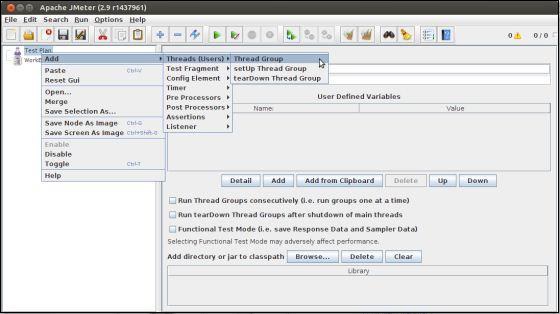
To remove an element, make sure the element is selected, right-click on the element, and choose the "remove" option.
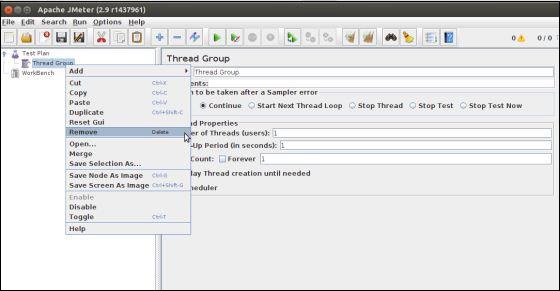
Step 3: Load and Save the Elements
To load an element from file −
- Right-click on the existing tree element to which you want to add the loaded element.
- Select Merge.
- Choose the file where you saved the elements.
- JMeter will merge the elements into the tree.
By default, JMeter does not save the element, you need to explicitly save it.
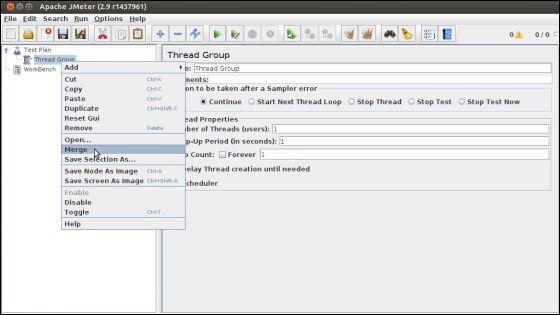
To save tree elements −
- Right-click on the element.
- Choose the Save Selection As ... option.
JMeter will save the element selected, plus all the child elements beneath it. By default, JMeter doesn't save the elements, you need to explicitly save it as mentioned earlier.
Step 4: Configuring the Tree Elements
Any element in the Test Plan can be configured using the controls present in JMeter's right-hand side frame. These controls allow you to configure the behavior of that particular test element. For example, the Thread Group can be configured for a number of users, ramp up periods, etc., as shown below −

Step 5: Saving the Test Plan
You can save an entire Test Plan by using either Save or "Save Test Plan As ..." from the File menu.
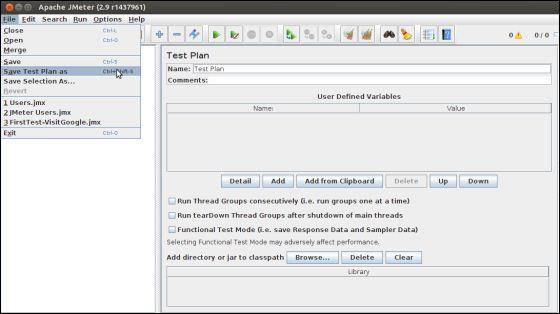
Step 6: Run the Test Plan
You can run the Test Plan by clicking Start(Control + r) from the Run menu item. When JMeter starts running, it shows a small green box at the right-hand end of the section just under the menubar.
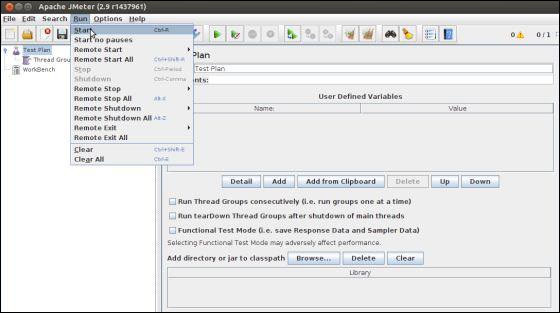
The numbers to the left of the green box are the number of active threads / total number of threads. These only apply to a locally run test; they do not include any threads started on remote systems when using client-server mode.
Step 7: Stop the Test Plan
You can stop your test in two ways −
Using Stop (Control + '.'). It stops the threads immediately if possible.
Using Shutdown (Control + ','). It requests the threads to stop at the end of any current work.